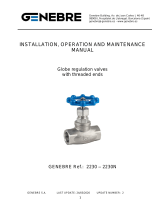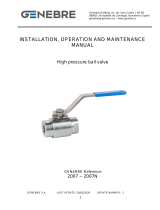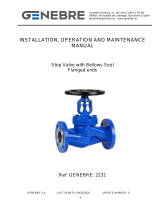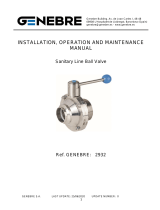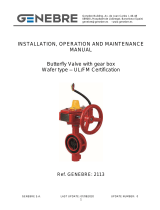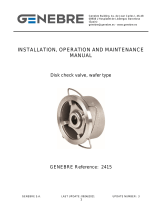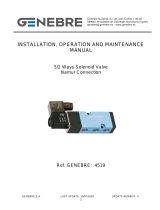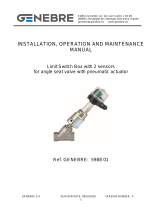Page is loading ...

Genebre Building. Av. de Joan Carles I, 46-48
08908 L'Hospitalet de Llobregat. Barcelona (Spain)
[email protected] - www.genebre.es
GENEBRE S.A.
LAST UPDATE: 25/03/2020 UPDATE NUMBER: 0
1
INSTALLATION, OPERATION AND MAINTENANCE
MANUAL
Flanged ends Gate Valve
Ref. GENEBRE: 2229A

Genebre Building. Av. de Joan Carles I, 46-48
08908 L'Hospitalet de Llobregat. Barcelona (Spain)
[email protected] - www.genebre.es
GENEBRE S.A.
LAST UPDATE: 25/03/2020 UPDATE NUMBER: 0
2
Installation, operation and maintenance instructions
1. Product description ............................................................................... 3
2. Transport and Storage conditions ....................................................... 3
3. Exploded drawing ................................................................................... 4
4. Installation instructions …….............................................................. 5
4.1 Preparation ………………….................................................................. 5
4.2 Installation of valves with flanged ends ……..……………………... 6
5. Operating instructions
5.1 Usage .................................................................................................... 6
5.2 Manual operation .................................................................................. 7
6. Maintenance instructions ...................................................................... 7
7. Reparation instructions ....................................................................... 8
8. Hygiene and Safety Instructions ........................................................... 8

Genebre Building. Av. de Joan Carles I, 46-48
08908 L'Hospitalet de Llobregat. Barcelona (Spain)
[email protected] - www.genebre.es
GENEBRE S.A.
LAST UPDATE: 25/03/2020 UPDATE NUMBER: 0
3
1. Product description.
Genebre, S.A. offers a wide range of valves designed and assembled to handwheel and
drive fluids in industrial procedures.
The compatibility of materials used to build the valves (see technical specifications) and
the application of valves to the different industrial processes is at user's risk. Valves will
have an optimal behavior when working conditions do not exceed pressure and
temperature limits (pressure curve) for which they have been designed.
2. Transport and Storage conditions
Transport and storage of this kind of products must be done keeping them in their
original package!
VISUAL INSPECTION
Check whether during transport, unloading and placement the products have suffered
damages.
During storage it is recommended to keep them into the included protective wrapping to
avoid damages or dirt accumulation in the inside part of the valve.The wrap must not be
removed until valve is to be installed.
Valves must be stored in a dry and clean environment.
If you notice any kind of anomaly during reception of the goods, contact immediately
with GENEBRE in order to determine the possible responsibilities on the issue.
IMPORTANT NOTE:
Before installing and/or manipulating these elements, READ CAREFULLY these
instructions for use and OBSERVE all contained information. If you fail to
understand any of their content, please contact GENEBRE, S.A.

Genebre Building. Av. de Joan Carles I, 46-48
08908 L'Hospitalet de Llobregat. Barcelona (Spain)
[email protected] - www.genebre.es
GENEBRE S.A.
LAST UPDATE: 25/03/2020 UPDATE NUMBER: 0
4
User is responsible for the safe use of these products, according to present
instructions for use and specific technical documentation of the device.
3. Exploded drawing
Yoke ≥ 10”

Genebre Building. Av. de Joan Carles I, 46-48
08908 L'Hospitalet de Llobregat. Barcelona (Spain)
[email protected] - www.genebre.es
GENEBRE S.A.
LAST UPDATE: 25/03/2020 UPDATE NUMBER: 0
5
Nº
Name
Material
Surface Treatment
1
Body
ASTM A216 WCB
Painted
2
Seat
ASTM A105 + 13 Cr
------
3
Wedge Disc
ASTM A216 WCB + 13 Cr
------
4
Stem
ASTM A276 - 410
------
5
Bonnet Bolt
ASTM A193 Gr. B7
------
6
Bonnet Nut
ASTM A194 Gr. 2H
------
7
Body Gasket
S.S 304 + Graphite
------
8
Bonnet
ASTM A216 WCB
Painted
9
Back Seat Bushing
ASTM A276 - 410
------
10
Stem packing
Graphite
------
11
Bolt
ASTM A193 Gr. B7
------
12
Nut
ASTM A194 Gr. 2H
------
13
Stem Nut
ASTM A536 80-55-06
------
14
Handwheel
Cast Iron
Painted
15
Handwheel Nut
Carbon steel
------
16
Gland Nut
Carbon steel
------
17
Gland Flange
ASTM A105
------
18
Gland
ASTM A276 - 410
------
19
Yoke
ASTM A216 WCB
Painted
20
Yoke Bolt
ASTM A193 Gr. B7
------
21
Yoke Nut
ASTM A194 Gr. 2H
------
4. Installation instructions
4.1) Preparation
Remove any material remains of the valve wrapping.
Serious problems may arise with the installation of a valve in a dirty pipe.
Make sure the pipe is not dirty and doesn’t have welding particles, for example, before
installing it. This may cause irreparable damages in the valve when the equipment is
started → prepare a clean working area.
Plan beforehand enough space for future maintenance operations.

Genebre Building. Av. de Joan Carles I, 46-48
08908 L'Hospitalet de Llobregat. Barcelona (Spain)
[email protected] - www.genebre.es
GENEBRE S.A.
LAST UPDATE: 25/03/2020 UPDATE NUMBER: 0
6
Control the correct performance of the valve by turning the handwheel both sides (close
and open) and observing if the disc or needle slides correctly. If this is not the case,
check if there are foreign particles inside the valve and repeat the whole operation.
In case of vibrations in the pipe it is strongly recommended to mount anti-vibration
elements to absorb them. Otherwise, the life of the product could be drastically reduced
4.2) Installation of valves with flanged ends
Do not disassemble the valves to install them.
Make sure the pipe's and edges flanges of the valve are clean.
Use the corresponding screws in all of the flanges drill holes.
Place an adequate joint in each end and align it in the center of the flanges.
Tighten screws evenly and cross-shaped to avoid deformations. To do so, you must not
force in any case the pipe to center the valve; it should take its position smoothly. Last,
verify that screws are tightened with the recommended torque for each type of screw.
Make sure the flanges joints are well placed.
After assembling, check the tightness and performance of the valve.
Valves do not have to support pipe's efforts so it is advisable to anticipate a good
alignment and parallelism of such pipe.
It is also recommended to use filters in the pipe to extend lifecycle of the valve.
When installed on steam systems a suitable steam trap should be fitted
immediately upstream of the isolation valve to drain condensate. This will ensure
drainage of the pipe when the valve is closed and will prevent damage of the valve
due to waterhammer.
5. Operating instructions
5.1) Usage
GENEBRE valves provide a leakproof lock when used adjusted to the pressure and
temperature values for which they have been designed.

Genebre Building. Av. de Joan Carles I, 46-48
08908 L'Hospitalet de Llobregat. Barcelona (Spain)
[email protected] - www.genebre.es
GENEBRE S.A.
LAST UPDATE: 25/03/2020 UPDATE NUMBER: 0
7
Valve materials have to be fully compatible with the fluid circulating through the valve.
Otherwise, valve could be seriously damaged.
Do not use for slurries or fluids containing solids that can build up in valve
cavities.
5.2) Manual operation
When operating the valve, you must avoid excessive lateral efforts with the handwheel.
To close, the operation consists in turning the handwheel clockwise and anticlockwise if
you want to open the valve.
Always open isolation valves slowly to avoid system shocks.
6. Maintenance instructions
Frequency, place and process of maintenance will be determined by the user by taking
into account usage of the product. However, periodical checks explained below will be
useful to extend the service life of the valve and reduce installation problems.
6.1) Valves must not remain in open or closed position for a long period of time. It is
recommended, if the process allows for it, to operate it for control purposes every six
months.
6.2) Verify possible leaks in the stem area; in case they exist, it is likely that the bellows is
damaged; valve should be replaced (see section 6).
6.3) Verify possible leaks through the line (due to closure); this defect is probably caused
by deposition of impurities between the disc or needle and the seat, transported by the
fluid. Disassemble the valve from the pipe, clean it thoroughly and reinstall it. If the
problem persists you should change the valve, since it is possible that some metallic
parts used for closure are damaged (erosion, corrosion). See section 6 for further details.
6.4) Keep the stem well greased, for it use the lubricating nipple.
“Pay attention, that the lubricant is suitable for the media”.
Lubricating
Nipple

Genebre Building. Av. de Joan Carles I, 46-48
08908 L'Hospitalet de Llobregat. Barcelona (Spain)
[email protected] - www.genebre.es
GENEBRE S.A.
LAST UPDATE: 25/03/2020 UPDATE NUMBER: 0
8
7. Reparation instructions
These types of valves, due to their assembling specifications are not worth repairing,
because most of the times are simply not cost-effective, so we recommend to directly
replace them.
8. Hygiene and Safety Instructions
8.1) Fluid passing through a valve or accessory can be corrosive, toxic, flammable or
pollutant. They can also be found at very high or low temperature. When operating
valves, you must follow the security instructions and it is recommended to use personal
protection gadgets:
1) Protect your eyes.
2) Wear gloves and appropriate working clothes.
3) Wear safety footwear.
4) Wear a helmet.
5) Have running water at hand.
6) To operate flammable fluids, make sure you have an extinguisher at hand.
8.2) Before removing a valve from a pipe, check always if the line is completely
drained and depressurized.
8.3) Operate the valve in open position to make sure there is no pressure in the internal
cavity.
8.4) Any valve being used by toxic services department needs to obtain a cleanliness
certificate before being operated.
8.5) Any type of repair or maintenance should be performed in ventilated places.
Before disassembling the pipe's valve to clean or replace it, make sure that line
has been closed and depressurized because a bad operational procedure could
cause a serious accident to staff and installation system
Before installing new valve, check if it meets the requirements of the valve
being replaced
/
